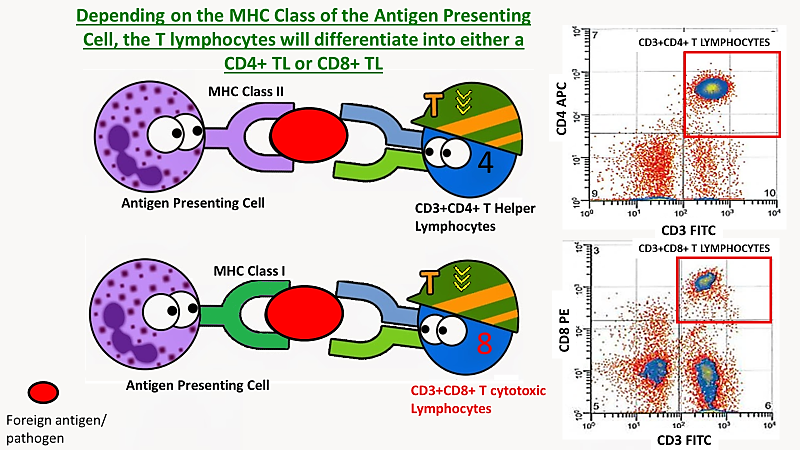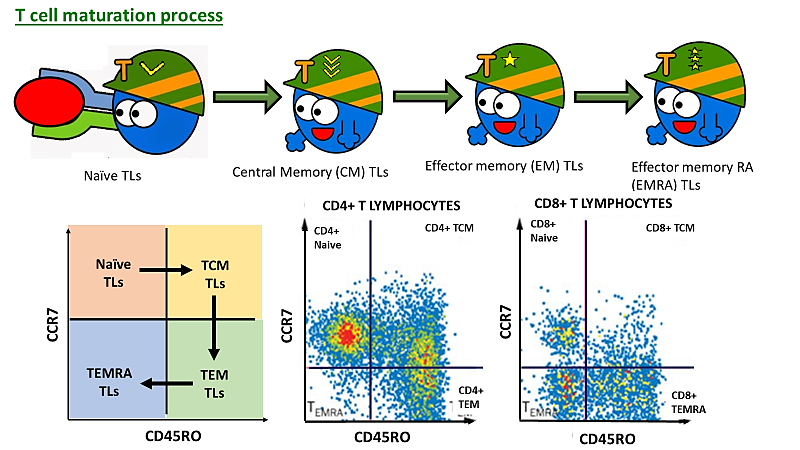Human immunity is a complex intricate battalion involving a plethora of different cells cooperating to ensure the health of an individual. Because of the diversity of immune cells, flow cytometry represents the best method for studying functional and phenotypic properties of these cell subsets, especially with the ever-expanding list of Cluster of Differentiation (CD) markers.
The immune system comprises of two distinct arms that are inextricably linked; innate and adaptive immunity. The primary role of the innate immune system is to provide a first line of defence by limiting the colonization of invading pathogens until antigen-specific adaptive immune responses are established.
In this article we will be discussing only on adaptive T cell immunity, essentially conferred by the T lymphocytes and how flow cytometry facilitates the in-depth study of lymphocytes. This group of cells have the capability to generate antigen-specific immune responses to a foreign antigen and the ability to induce “immunological memory” that confers rapid and enhanced protection upon subsequent antigen recognition.
The adaptive immune system can be illustrated with an army of soldiers with different “ranks” ready for war. It comprises two classes of specialised cell types which correspond to cell-mediated and humoral immunity respectively: the T-lymphocytes (TLs) and B-Lymphocytes (BLs). T-Lymphocytes that involve cell mediated immunity can be separated into cytotoxic CD8+ TLs and helper CD4+ TLs, which together account for 60-80% of the total lymphocytes in the peripheral immune system.
The thymus is a “training facility” where the Lymphoid progenitors undergo a rigorous “selection” process, where their surface T Cell Receptor (CD3) is tested for its functionality. Only cells that express T Cell Receptors (TCRs) with low affinity for self-peptide are positively “selected” to complete their maturation as naive TLs. This process prevents auto-immunity where the T lymphocytes start recognising the host cells wrongly as “foreign” and start attacking them, leading to self-destruction.
So how do the T cell know what is their identity and what type of cell to mature into? Depending on the specificity of the TCR for peptide-MHC Class I or peptide-MHC Class II antigens on antigen presenting cells, this will direct differentiation to either the CD8+ cytotoxic TLs or CD4+ T helper lineage respectively. The role of CD3+CD4+ T helper cells is to secrete cytokines that recruit other immune cells to regulate and enhance immune responses, while CD3+CD8+ Cytotoxic T cells on the other hand produce immunologic chemicals to induce cytotoxicity that aid in the eradication of infected or mutated cells
Moving further forward, there are four well characterized major T cell subsets; naïve TLs, central memory (Tcm TLs), Effector memory (Tem TLs) and effector memory RA (Temra TLs). These TLs subsets can be categorized by a number of markers such as CD45RA, CD45RO, CD62L and CCR7. Using 2 surface markers of CD45RO and CCR7 in flow cytometry, we can demonstrate a simplified model to depict the T lymphocyte maturation journey. However, are these surface markers just “facial” features that differentiates one another? Nope! In fact, these surface markers dictate where their position is and where they perform their duties. While some surface markers differentiate who the new recruits are and who the “experienced” soldiers are.
As we all know the more experienced soldiers will get promoted to a higher rank in the army; similarly as the Naïve TLs get exposed to an antigen, they will mature and be promoted to next rank. In flow cytometry terms, the Naïve TLs can be identified by the expression of CD45RA however, once they come into contact with an antigen, they will become “antigen-experienced” and lose the CD45RA expression while gaining CD45RO expression to be “activated” to perform its immunologic function. This is synonymous to dropping the dummy rifle once they passed their training in exchange of a real rifle to begin real war against a real enemy.
As mentioned earlier, immunological memory is the hallmark of adaptive immune system. It enables the immune system to respond more aggressively and rapidly to obnoxious pathogens that have been encountered previously. Two characteristically distinct antigen-experienced CD45RA-CD45RO+ memory TL populations have been widely recognised; the Central memory (Tcm TLs) and Effector memory (Tem TLs). CD62L and CD197 (CCR7) are two common surface markers that distinguishes the two populations.
Expression of CD62L and CCR7 on Central memory Tcm TLs gives them the right to operate and defend within the territory of the lymph nodes. Commonly known as “lymph-node homing markers”, both these markers act similarly like a passport/visa to signify lawful permission to enter or live in a country. Despite lacking immediate effector functions they are able to proliferate and rapidly differentiate into effector cells upon secondary stimulation as well as producing IL-2.
In contrast, the absence of CD62L and CCR7 on Effector memory Tem TLs forbids their entry into the lymph nodes, but express CXCR3 to patrol in the blood stream surrounding the peripheral tissues.
In summary, Tem act as frontiers of immunity against recall Ag, while Tcm is responsible for providing long-term immunity and generating a second batch of effector T cells on secondary challenge.
So here is just a quick snapshot of what the cell-mediated and humoral mediated adaptive immunity is all about. However, understanding the above phenotypic information is just the tip of an iceberg of what human immunity is all about. Understanding how drugs can affect all these lymphocytic population in a diseased state is a long arduous process. Fortunately, the rapid advancement of flow cytometry will be the key to future drug discovery.
Disclaimer
1. Flow cytometric analysis images depicted in this article are for simplified illustration purposes only and shall not constitute the exact analysis process
2. Information provided are for informal reading and not for official research usage
3. Views or opinions presented in this post are solely those of the author and do not represent those of the company or manufacturer. The author accepts no liability for the content of this post, or for the consequences of any actions taken on the basis of the information provided.




This article is very much convincing and appealing. I have got to learn a lot from this article. You might be having the curiosity to know about our company and what business we are dealing with. If you are looking for the client list to achieve your business goals, E-Health Care Lists helps you in reaching that goal by providing you with the prepackaged and customized database which helps you to come across the qualified and interested audiences that places an immediate order for your products. Please refer to Hematologist Email List & Mailing List for more information.
ReplyDeleteThanks for sharing the valuable information. Your article gave me a lot of information. We at Techno Data Group would like to introduce to you about our organization. We are the leading database providers for b2b marketing across the globe. we provide you with the readymade as well as the personalized email list and connect you with the right client or decision-makers. Please refer our Hematologist email & mailing list for further details.
ReplyDeleteVery impressive article! The blog is highly informative and has answered all my questions. To introduce about our company and the activities, Pegasi Media Group is a database provider that helps you to boost your sales & grow your business through well-build Hematologist email list
ReplyDelete